For the traveler devoted to history, rugged seascapes, and earnest hospitality, an exploration of the best things to do in Halifax offers a perfect blend of elements. The largest city and capital of the Canadian province of Nova Scotia, the port town is small enough that a visitor can see the main sights in a day—but rich enough in attractions to warrant several exploratory treks.
Established in 1749, Halifax resides along a sea that defines so much of its identity. The Atlantic port was built on the industries of fishing, fur trading, and shipping, but its 21st-century identity welcomes lovers of vibrant art, live music, tourist-friendly museums, and traditionally strong hospitality.
Whether you’re intrigued by the past or excited about the modern nature of this iconic Canadian city, this collection of destinations and experiences will unveil its true identity. Here are 14 things to do in Halifax, Nova Scotia.
Picnic in Point Pleasant Park
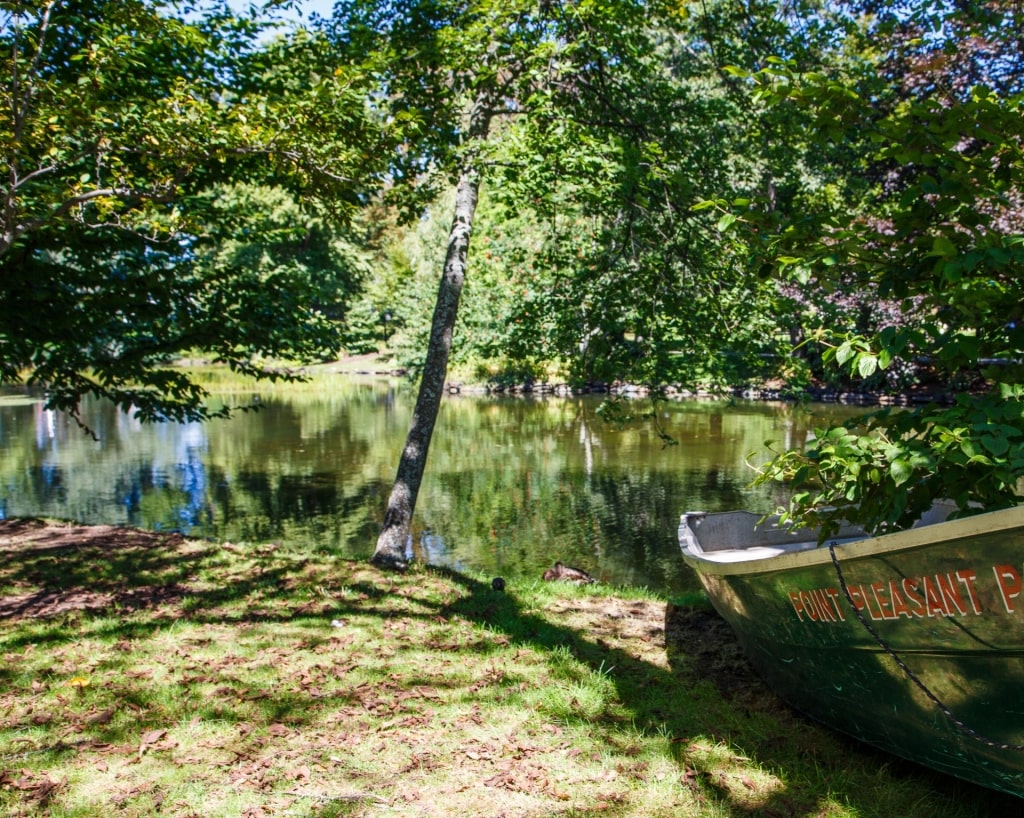
Point Pleasant Park
Much of Halifax settles into the peninsula bearing the city’s name, and Point Pleasant Park sits on that stretch’s southern end.
The richly-wooded, 75-hectare space offers almost 25 miles of walking paths and hiking trails, special cycling routes, and annual productions by the Shakespeare by the Sea theatre troupe in season.
There are historic ruins of past settlements with military fortifications and picnic areas. Point Pleasant Park is a great way to spend a low-key day soaking up the Halifax atmosphere.
Walk End to End on Spring Garden Road

Spring Garden Road Photo by Citobun on Wikimedia Commons, licensed under CC BY-SA 4.0
A major pedestrian space in the city’s heart, Spring Garden Road offers an opportunity for a great walking tour through shops, cafés, restaurants, and small arts and crafts galleries.
It’s recently been refurbished with expanded sidewalks and improved paving to welcome visitors throughout all four seasons.
Stop for a snack and try the local specialties: seafood, particularly oysters, scallops, and lobster, and in season, dishes made from berries and locally grown apples.
The official local dish is donair: beef that’s cooked on a spit and then sliced into pita bread and served with garlic sauce, onions, and tomatoes.
Read: Best Fall Foliage Cruise Destinations
Turn a Page at the Halifax Central Library

Halifax Central Library Photo by Citobun on Wikimedia Commons, licensed under CC BY-SA 4.0
Anchoring one end of Spring Garden Road is the impressive modern architecture of the Halifax Central Library.
A free cultural center in one of Halifax’s most vibrant areas, the facility offers far more than its comprehensive book and periodical collection for locals. The building includes cafés, a theater and exhibit space for rotating art and cultural shows.
Even visitors who don’t have time to explore inside the Central Library can enjoy its inspiring design from Spring Garden Road. The library is considered an architectural landmark throughout Canada; this gravity-defying building features a fifth-floor that’s cantilevered out over the entrance plaza.
Smell the Flowers at the Halifax Public Gardens
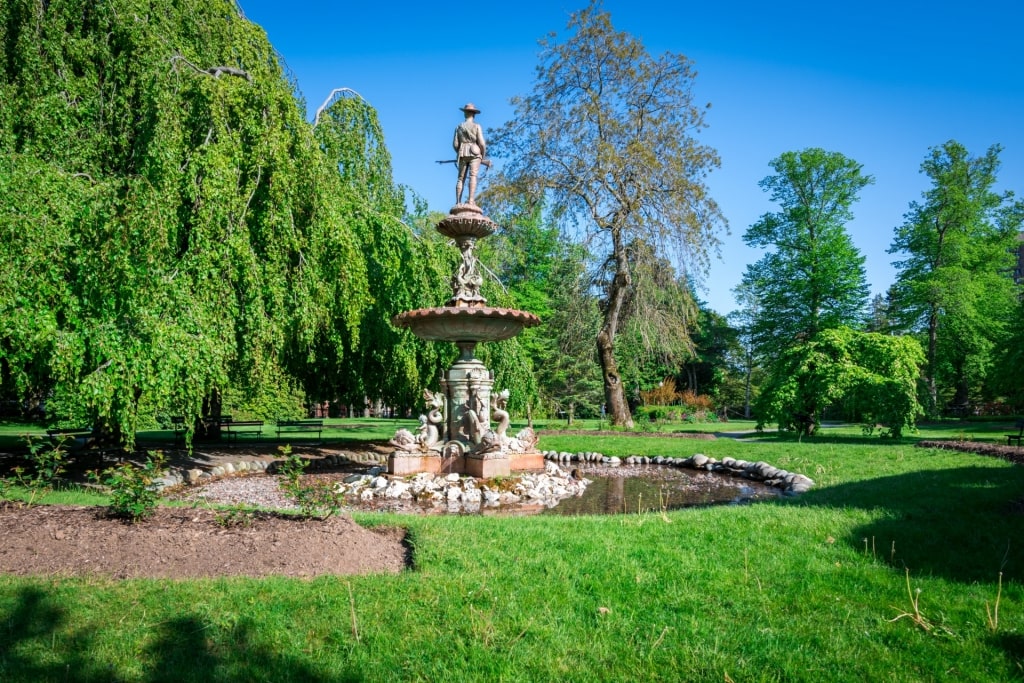
Halifax Public Gardens
On the far end of Spring Garden Road from the Halifax Central Library and opposite Victoria Park, the Halifax Public Gardens welcome everyone from botany lovers to those just seeking some green peace and quiet.
An official National Historic Site of Canada, the original garden opened in 1867 to celebrate the Canadian Confederation and covers more than 16 acres. Open to the public seasonally from May 1 until November 1, the garden contains multiple historical monuments and war memorials tracing the nation’s history.
Catch Your Breath at St. Mary’s Cathedral Basilica
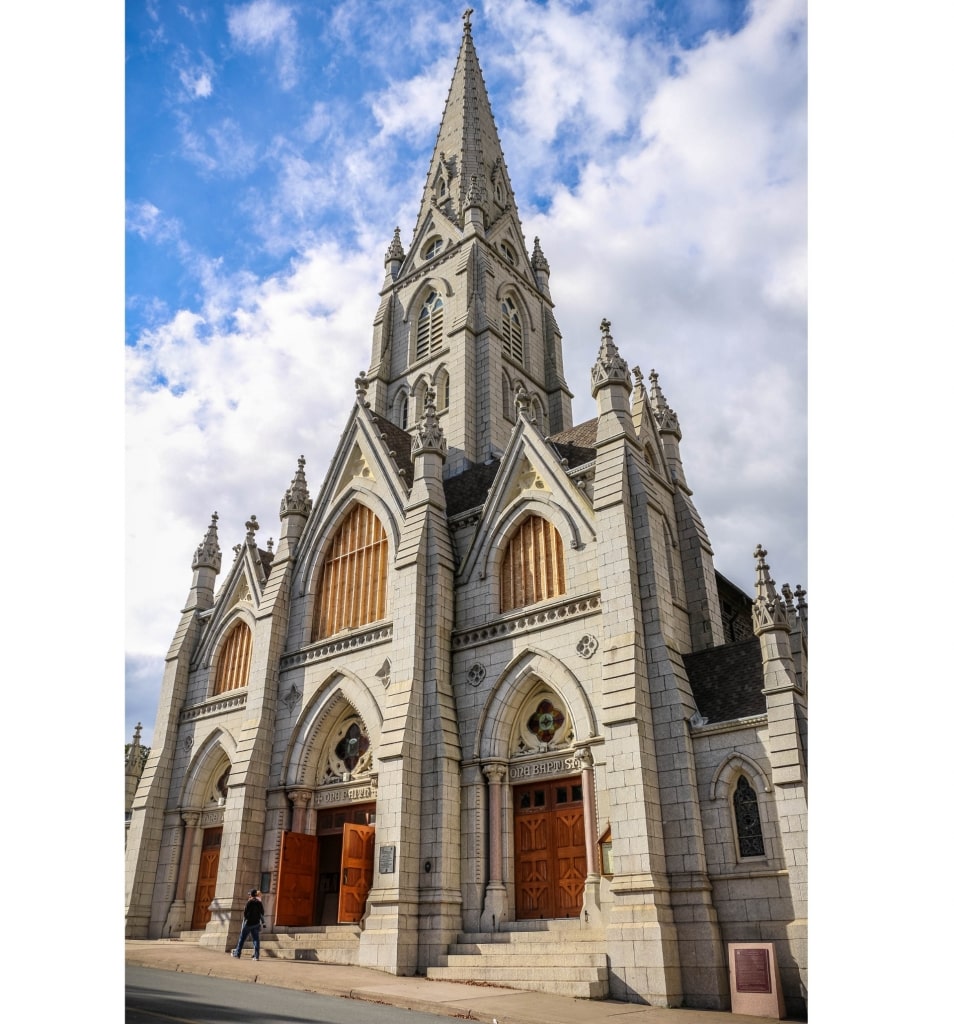
St. Mary’s Cathedral Basilica
Also within walking distance from Spring Garden Road, St. Mary’s Cathedral Basilica is a Gothic Revival design originally built in 1899.
Visitors from all walks of life can enjoy a quiet stroll through the Basilica’s cemetery where graves date back to 1843.
March to Grand Parade Square
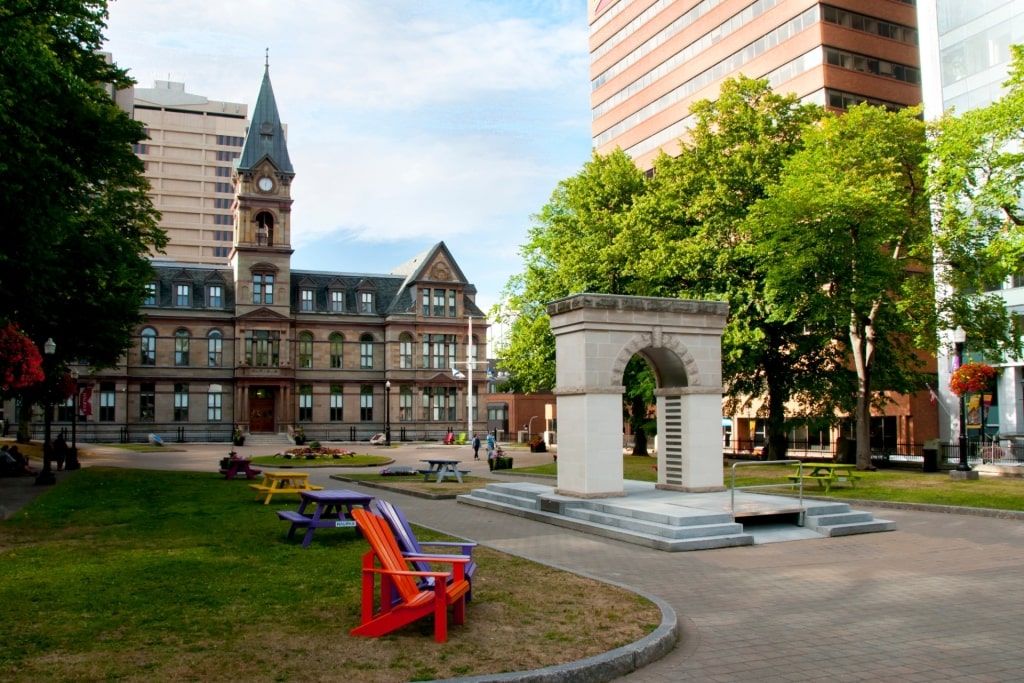
Grand Parade Square
A simple public space in the city centre, the Grand Parade Square spreads out before Halifax City Hall and dates back to the founding and defense of the original city in 1749.
The square serves as the political and official social hub of Halifax, and visitors stopping by the space can catch everything from live performances to political protests.
See the Light at Peggy’s Cove

Peggy’s Cove
For visitors with time to venture away from downtown Halifax and head west on a day trip across the Terence Bay Provincial Wilderness Area, the picturesque vistas of Peggy’s Cove offer the beauty of a 19th century Winslow Homer painting in our 21st-century world.
A fishing village dating back to 1811, Peggy’s Cove stands about 26 miles from the city center of Halifax and clings to its rustic, working-class identity.
While its surrounding environment is officially listed as a natural preservation area, local residents of this stunning seaside village are still allowed to fish the regional waters.

Peggy’s Point Lighthouse
While government statistics say Nova Scotia holds more than 160 lighthouses, the Peggy’s Cove version remains the region’s most famous seaside beacon and an unofficial symbol of the Halifax area.
Often listed as one of the “most photographed” spots that Canada is known for, the Peggy’s Point Lighthouse was built in 1915 and remains in service.
Dive Into Titanic’s History at the Maritime Museum of the Atlantic

Maritime Museum of the Atlantic
Founded in 1948, the Maritime Museum of the Atlantic holds more than 30,000 artifacts, including thousands of photographs, charts, rare books, and ship models. The institution also preserves Canada’s largest collection of ship portraits, including the oldest such painting in the country.
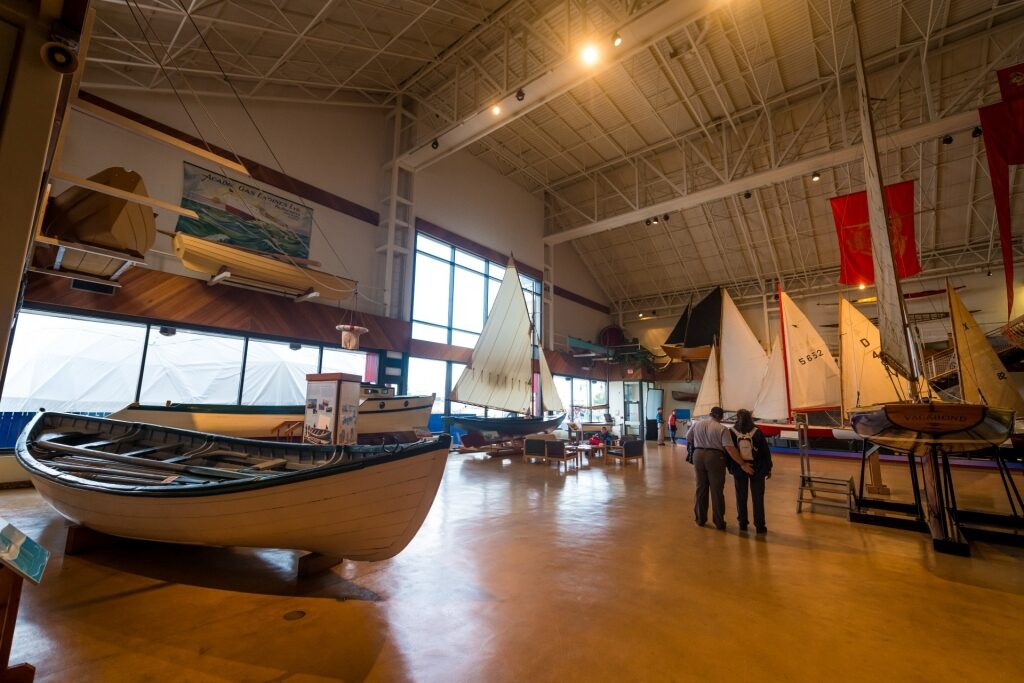
Maritime Museum of the Atlantic
Standing in its current wharf location since 1985, the museum’s attractions include exhibits on the Canadian Navy and its role in World War II’s supply convoys and the Battle of the Atlantic.
There’s a look at causes and artifacts of the Halifax Explosion, and detail on the history of Canadian shipwrecks. However, the Maritime Museum of the Atlantic’s most popular attraction is its exploration of the most famous shipwreck of all time—the loss of RMS Titanic.
Halifax and Nova Scotia have a profound connection to the legendary lost ocean liner as the province’s cable ships were some of the first vessels recruited into a rescue fleet.
Now, the museum shows the world’s largest collection of wooden artifacts from Titanic, including one of its famous deck chairs.

Fairview Lawn Cemetery
The 150 deceased brought back to Halifax by its cable vessels are interred at Fairview Lawn Cemetery, Mount Olivet Cemetery and Baron de Hirsch Cemetery—all open to public visits.
Get in the Frame at the Art Gallery of Nova Scotia
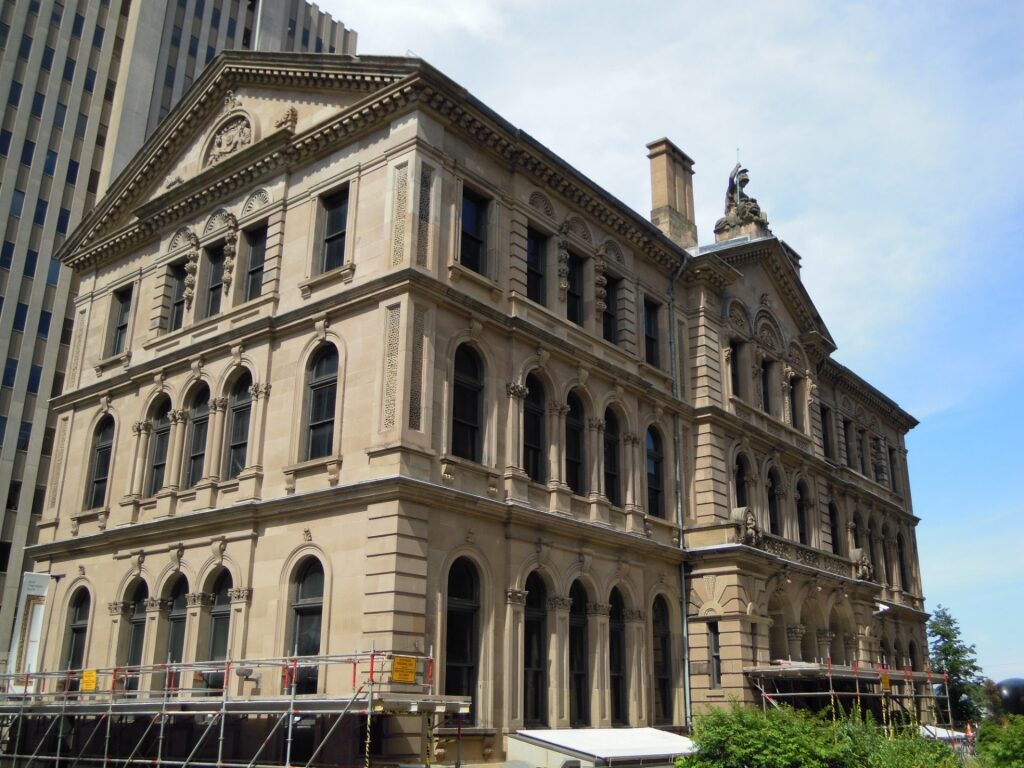
Art Gallery of Nova Scotia Photo by Skeezix1000 on Wikimedia Commons, licensed under CC BY-SA 3.0
Located in downtown Halifax, the Art Gallery of Nova Scotia was originally established in 1908 and underwent multiple moves, renovations and expansions over the years.
The gallery now includes more than 18,000 works in its permanent collection, with more than 2,000 of them originating in Nova Scotia and surrounding Canadian territories.
The gallery’s most famous collection might be the more than 2,000 photographs by Annie Leibovitz donated to the museum, with a value of more than $4 million. Visitors can also take in new, rotating shows as the museum’s curators invite touring shows from around the world.
Explore the Sciences at Discovery Centre

Discovery Centre Photo by Ben MacLeod on Wikimedia Commons, licensed under CC BY-SA 4.0
Halifax visitors with children eager to explore the wonders of science can visit the Discovery Centre—an interactive museum exploring science, innovation and technology.
Based in the Halifax Seaport, the museum is based as much on education as entertainment with standing exhibits on Energy, Health, Flight and Oceans.
Browse the Historic Properties Shops
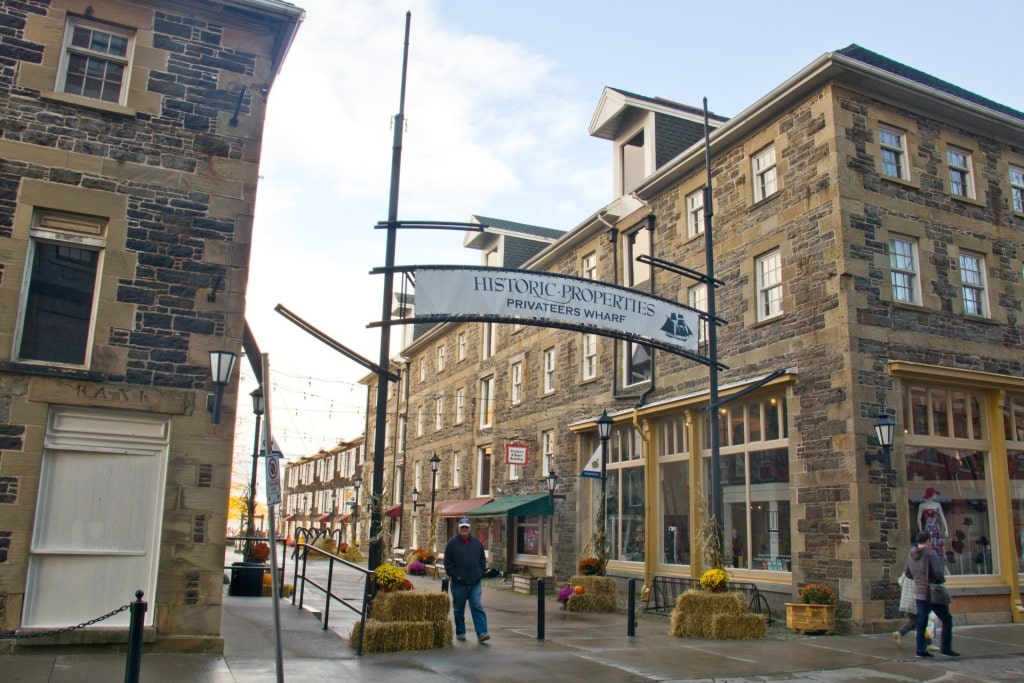
Historic Properties Shops Photo by Stewx on Wikimedia Commons, licensed under CC BY-SA 4.0
Located on Upper Water Street along the city’s port, the Halifax Historic Properties Shops nestle into the reaches of seven warehouses built between 1800 and 1875 as the city boomed and merchants begged for more space to expand their businesses.
Canada’s Historic Sites and Monument Boards deemed the buildings of historic importance in 1963, saving them from demolition.
Today, those warehouses still stand—though renovated to host a 21st-century collection of shops and businesses. Visitors to the properties today will find clothing retailers, small art galleries, flower and gifts sellers, jewelry designers, and a barbershop.
Climb the Halifax Citadel National Historic Site
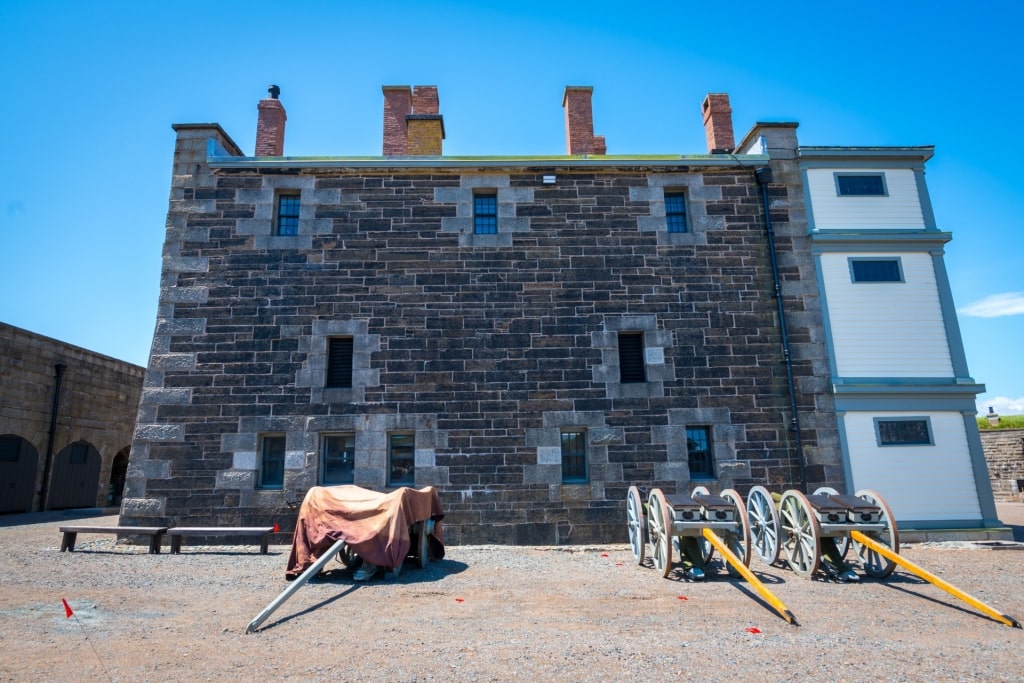
Halifax Citadel National Historic Site
Rising atop a prominent hill just outside the heart of downtown Halifax, the Citadel National Historic Site (sometimes referred to as Fort George or Citadel Hill) hosted four separate military fortifications through the decades.
The original dates back to the founding of Halifax by England in 1749. Since then, the different forts built on the hill rose to defend the city from different enemies, including the French and native tribes.
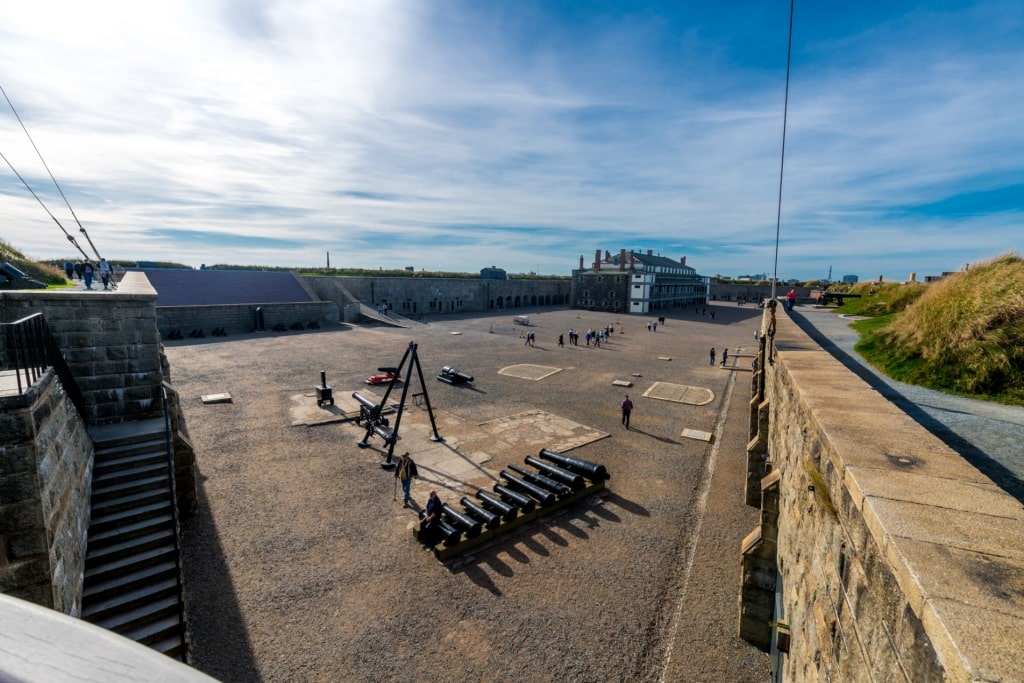
Halifax Citadel National Historic Site
The city’s founders oversaw the construction of the original Halifax from behind the original fort’s walls. The later armed structures were important in defending the Halifax Royal Navy Dockyard below through two centuries of shipping.
The current remaining fort, a star-shaped battlement topping the Citadel, dates back to 1826 and can now be toured by history buffs.
Strangely, though four separate military encampments rose on the hill, none of them were ever directly attacked by any enemy.
Pay Your Respects at the Halifax Explosion Memorials
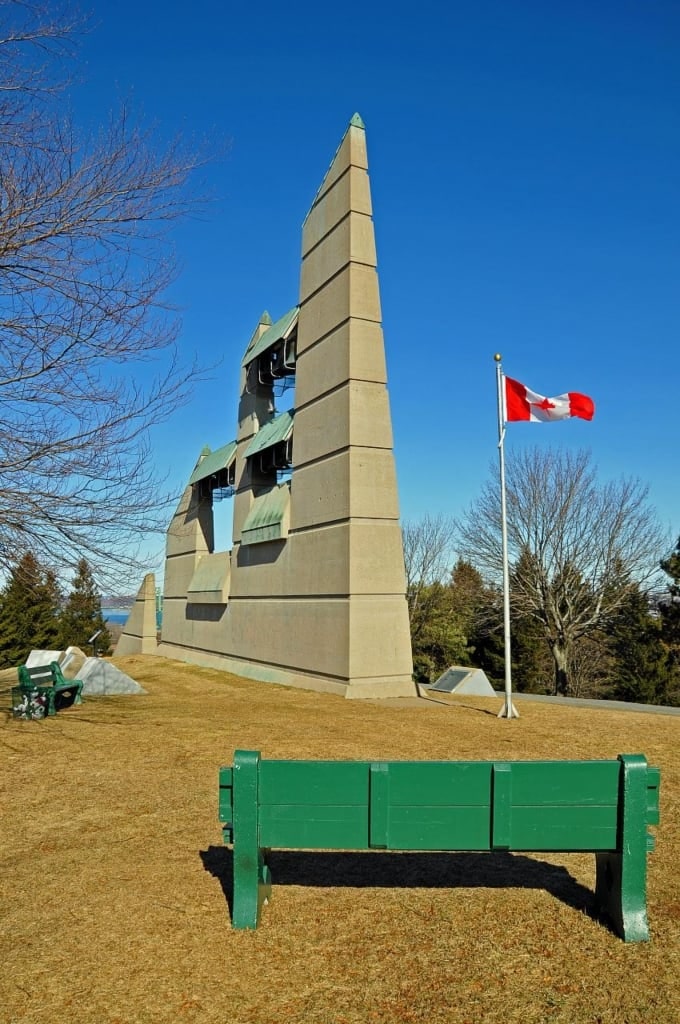
Halifax Explosion Memorials Photo by Dennis Jarvis on Flickr, licensed under CC BY-SA 2.0
For lovers of history and the strange series of incidents that play a role in our fates, visiting the memorials honoring the victims of the Halifax Explosion can prove a moving experience.
While not necessarily well known outside of Canada, the blast of 1917 remains one of the country’s biggest maritime tragedies and one of the greatest disasters in the country’s history.
During the First World War, the SS Mont Blanc—a French ship bound for Europe and heavily laden with explosives—met the SS Imo arriving from Norway.
Through a chain of coincidences and poor decisions by the ships’ captains, the Imo struck the Mont Blanc and caused a fire that set off the single largest, non-nuclear, artificial explosion in history—equal to 2.9 kilotons of TNT or one-seventh of the power of the Hiroshima atomic bomb.
Every structure in a radius of a half-mile was leveled, with 1,792 killed and more than 9,000 injured.
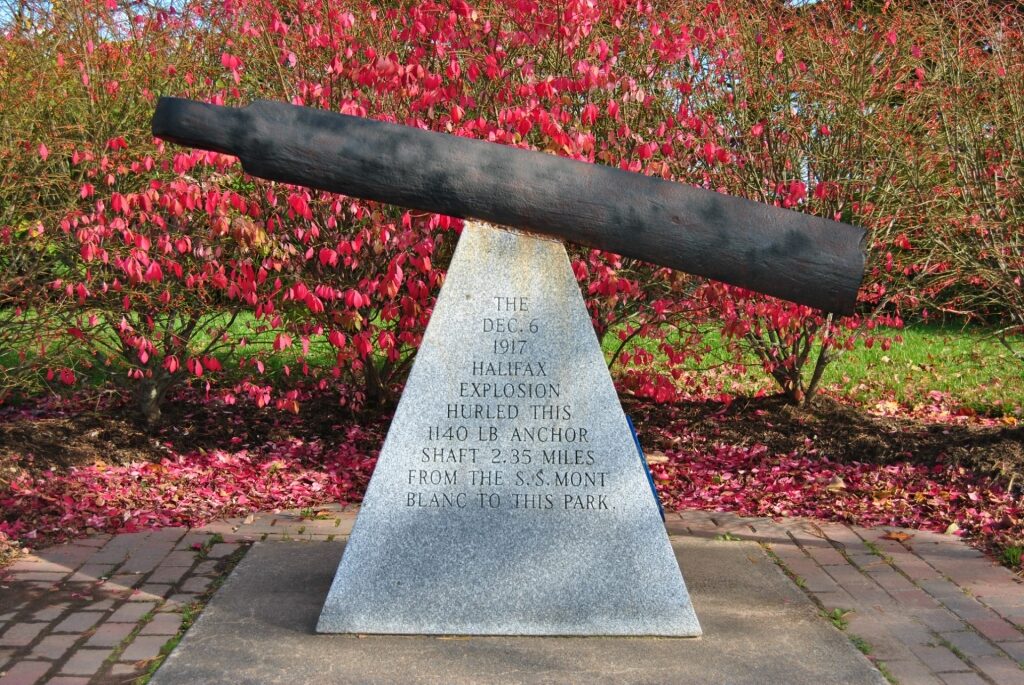
Halifax Explosion Memorials Photo by Vonkiegr8 on Wikimedia Commons, licensed under CC BY-SA 3.0
To honor those lost and to commemorate the event, two memorials stand in Halifax. The Halifax Memorial Bell Tower stands in Fort Needham Memorial Park on Union Street (about a 10-minute drive from the center of downtown).
As it stands in an open public park, it’s available for viewing all day. Meanwhile, the Mont-Blanc Anchor Memorial features all that’s left of that piece of the ship’s hardware—an iron anchor shaft the explosion tossed more than two miles.
The display stands near Regatta Point and the Chocolate Lake Recreation Centre.
Explore History at St. Paul’s Church
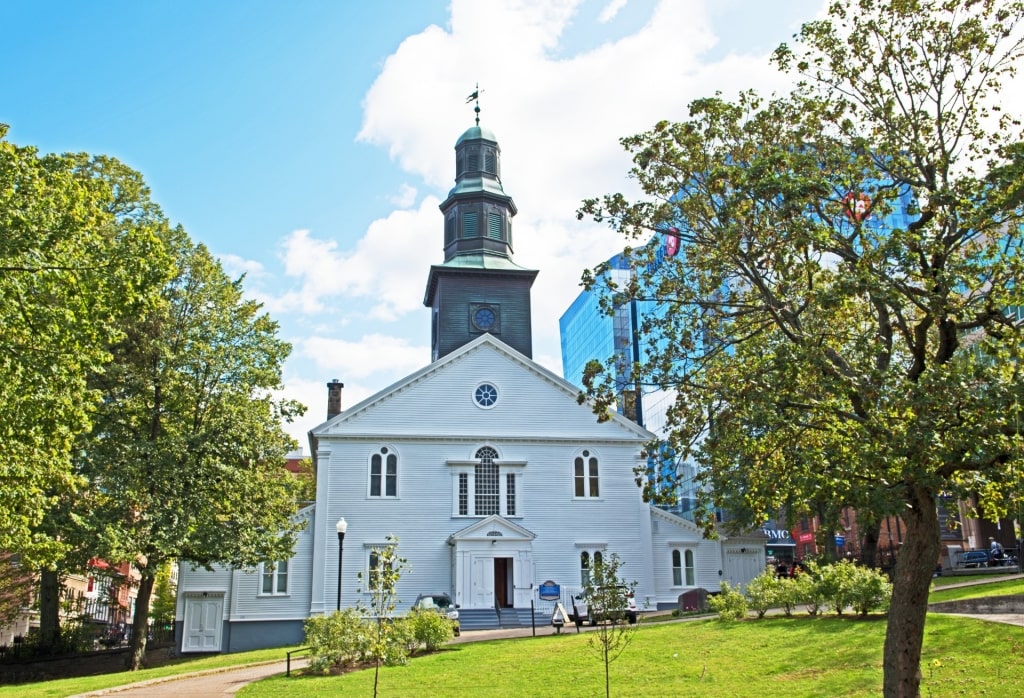
St. Paul’s Church
The oldest building in Halifax and the oldest serving Protestant church in all of Canada. St. Paul’s Church is a short walk from prominent landmarks such as the Halifax Central Library and the Halifax Public Garden. Built in 1750, the church’s architecture was based on St. Peter’s Church in London.
The church added another chapter to the connection of Halifax to the Titanic tragedy as it hosted the city’s first memorial service for the ship’s dead on April 21, 1912. Church records show the religious community gathered for the event before the recovery vessels returned to port.
As part of the oldest church in Halifax, the St. Paul’s Church cemetery remains one of the oldest burial sites in Nova Scotia. Its permanent guests include names that track the history of Halifax and indeed most of the eastern seaboard of North America.
You can catalog the memorials by historic era as the St. Paul’s Church burial markers include names from the founding of Halifax; individuals involved in Canada’s influence upon the American Revolution; and Canadiens who died during the French Revolution.
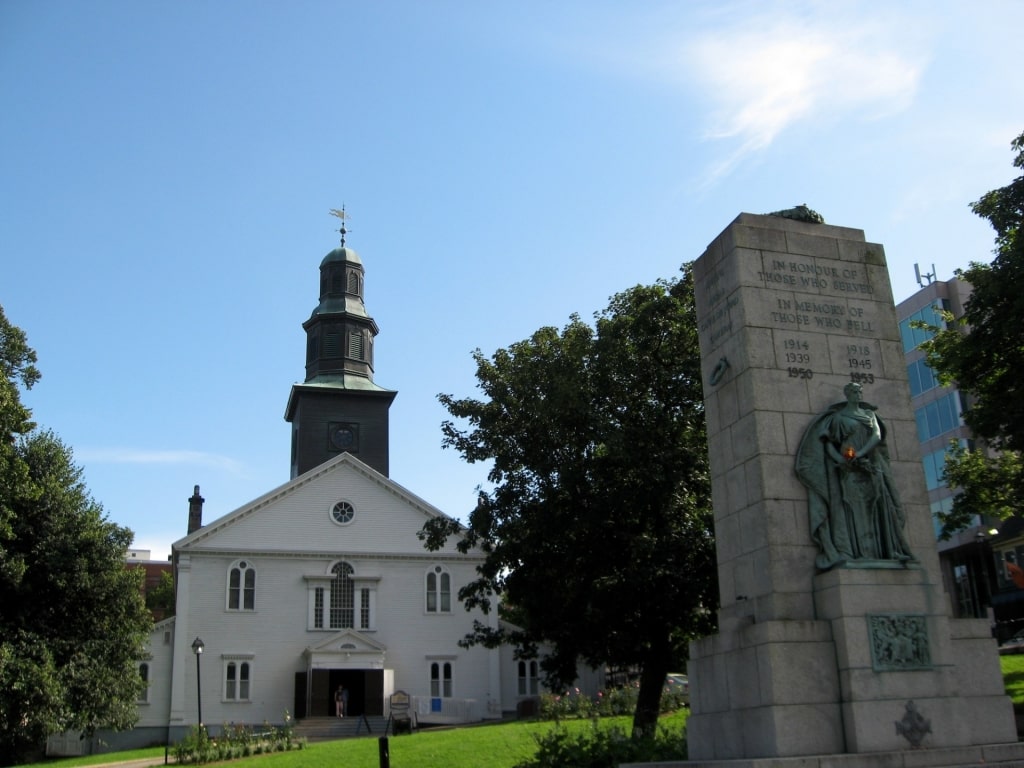
St. Paul’s Church Photo by Andrea Vail on Flickr, licensed under CC BY-ND 2.0
Many Boston and New York Loyalists were laid to rest at St. Paul’s—men and women who fled the foundling United States as they remained faithful to England and King George III. The Loyalists brought with them the unexpected dawn of racial integration into Halifax as freed black slaves from the American colonies accompanied the Loyalists north.
Finally, the oldest building in Halifax also offers up one of the oldest controversies in the city. Legend has it a clergyman serving at St. Paul’s Church in 1917 was standing near an upstairs window when the massive Halifax Explosion destroyed the town.
Though the church survived the destruction with non-lethal damage, the light and heat from the blast reportedly burned the silhouette of the clergyman into the glass panel forever. Some locals say you can still see the outline of the unfortunate priest’s profile in the glass to this day.
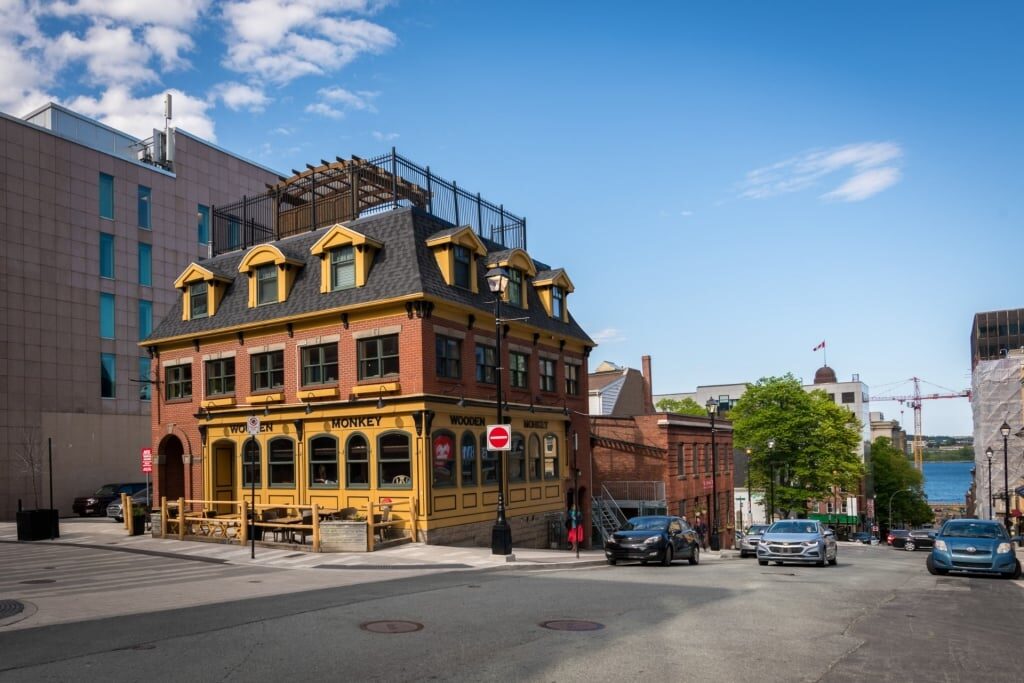
Halifax
Enjoying the best things to do in Halifax will educate the mind, enrich the soul and fill the belly with the town’s mix of fascinating history, seaside beauty, and wholesome cuisine.
However long you spend here, you’ll come away from Halifax with a better sense of working town life and honorable Canadian pride. Browse itineraries on our website and plan your cruise to Halifax.


